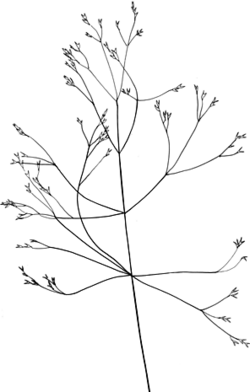Common Name: Bents (Agrostis), blowngrasses (Lachnagrostis)

Description: Tufted, rhizomatous, sometimes stoloniferous, often delicate annuals or perennials.
Leaves with ligule membranous; blade rolled in bud, flat, sometimes folded or involute, scabrous (at least the margins).
Inflorescence an open or contracted, usually much branched panicle of small spikelets.
Spikelets often gaping, with 1 bisexual floret, on slender pedicels, disarticulating above or below the glumes, the spikelets or florets falling from the persistent inflorescence (Agrostis s. str.) or the inflorescence disarticulating below the lowest branches (Lachnagrostis); rachilla often produced as a hairy bristle. Glumes equal or subequal, acute or acuminate, keeled, 1-nerved, membranous, often shining, awnless. Lemma usually shorter than the glumes, thin and soft, hairy or glabrous, 3–5-nerved, awnless or dorsally awned, callus hairy or glabrous. Palea shorter than the lemma, 0–2-nerved, thin, usually small, often absent.
Distribution and occurrence: World: c. 200 species, often in cold regions, especially of Northern Hemisphere. Australia: c. 15 species, (4 or 5 species naturalized), all States except N.T.
From the greek word for 'field'. The genus Lachnagrostis warrants distinction, but as yet only a few combinations are available; there are some new taxa; and the status of some of the non-N.S.W. species is uncertain. This group is currently under review. Some Agrostis species are valuable lawn grasses and others are useful components of pasture.
Text by S.W.L. Jacobs & S.M. Hastings
Taxon concept:
Taxa not yet included in identification key
Agrostis muelleriana
| | Key to the species | |
| 1 | Lemma awned | 2 |
| Lemma awnless | 4 |
| 2 | Awn minute and delicate (slender) arising from near the tip and as long as the lemma; panicle contracted | Agrostis muellerana |
| Awn 1.5–2 times as long as the lemma and rising from about the middle of the back; panicle open or contracted
Back to 1 | 3 |
| 3 | Spikelets 2–4 mm long; panicle open, with slender branches bare at the base for 2–6 cm | Agrostis venusta |
| Spikelets c. 2 mm long; panicle contracted, with erect branches divided or bearing spikelets to within 1 cm of their bases
Back to 2 | Agrostis boormanii |
| 4 | Palea absent or minute | 5 |
| Palea present, half to as long as the lemma
Back to 1 | 11 |
| 5 | Leaf blades flat, 2–3 mm or more wide (leaf bases of A. bettyae may be 1.5 mm wide) | 6 |
| Leaf blades narrow, often folded, usually to <2 mm wide
Back to 4 | 7 |
| 6 | Anthers <0.5 mm long; spiklets 1.8–2 mm long | Agrostis propinqua |
| Anthers 1 mm long or longer; spiklets 1.8–2.2 mm long
Back to 5 | Agrostis bettyae |
| 7 | Panicle contracted with erect branches; anthers 0.6–0.8 mm long | Agrostis muellerana |
| Panicle spreading, with branches often at right angles to the axis, anthers 0.3–0.5 mm long
Back to 5 | 8 |
| 8 | Panicle usually only partly exserted from the upper leaves, glumes usually scabrous to the base of the keel; culms usually leafy | Agrostis australiensis |
| Panicle much exserted on a long, smooth peduncle; glumes not scabrous to the base of the keel; leaves mostly crouwded at the base of the culms
Back to 7 | 9 |
| 9 | Anthers 0.3 mm long; leaves very fine, <1 mm wide when folded | Agrostis parviflora |
| Anthers 0.4–0.5 mm long; leaves to 2.5 mm wide when flat
Back to 8 | 10 |
| 10 | Pedicels mostly <2 mm long; inflorescence >2 times as long as wide, branches straight | Agrostis thompsoniae |
| Pedicles >2 mm long; inflorescence <2 times as long as wide, branches flexose
Back to 9 | Agrostis joyceae |
| 11 | Spikelets falling with the glumes;callus glabrous; panicle contracted, 3–15 cm long | Agrostis viridis |
| Spikelets disarticulating between the glumes and the lemma; panicle more or less open, at least at anthesis
Back to 4 | 12 |
| 12 | Ligule longer than broad; stoloniferous perennial; rhizomes, if present with only 3 scale leaves; panicle branches often contracted after anthesis | Agrostis stolonifera |
| Ligule more or less longer than broad; rhizomatous (sometimes stoloniferous) and tufted perennials; rhizomes with at least 3 scale leaves;panicle branches not usually contracted after anthesis
Back to 11 | 13 |
| 13 | Ligule shorter than wide, to 2 mm long; leaf blades to 5 mm wide; glumes only slightly scabrid on the keels. | Agrostis capillaris |
| Ligule longer than wide, to 6 mm long; leaf blades to 8 mm wide; glumes scabrid on the keels
Back to 12 | Agrostis gigantea |
|


